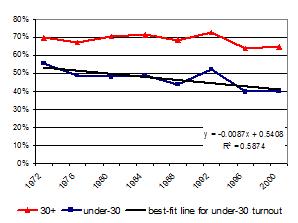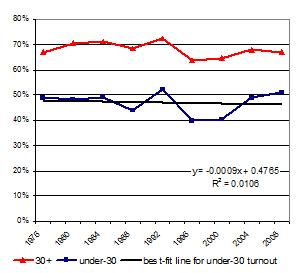« we're the ones we've been waiting for | Main | what the Dickens? »
May 5, 2009
making the youth voting problem go away
CIRCLE was founded in 2001 because of widespread concern that civic engagement was in decline, and a feeling that youth were the heart of the problem. Although everyone defined "civic engagement" as more than voting, the voting trend was a common symbol of the issue. The graph below shows turnout for young and older adults between 1972, when the voting age was lowered to 18, and 2000, just before CIRCLE was launched. Older adults' turnout stayed pretty steady, but under-30s were in steady decline. A straight line would track the actual youth trend pretty closely and would decline by almost one point per year, or 3.58 points per election cycle. (If you discard 1992 as an outlier, the r-squared is .89.) We seemed to have a generational problem.

But 1972 could be considered an anomaly. Young people had just won the right to vote, with much hoopla. There was still a draft and the Vietnam War was deeply unpopular. So we might discard 1972 as a baseline year. Besides, we now have data from 2004 and 2008. This is how the trend looks if we chose to run it from 1976-2008.

Ipso presto, the youth voting decline has vanished! No straight line can track the youth trend very well, but the best-fit line hardly declines at all (one tenth of a point per year). It now looks as if the norm is a steady youth turnout rate of around 48%, and the late 1990s represented an unusually low period that could be attributed, perhaps, to the specific campaigns and politicians of that era.
Well, there are lies, damned lies, and statistics. We shouldn't be allowed to make a problem appear or disappear by changing the parameters of a graph. But I would venture that declines and other changes over time are not nearly as striking as stability. We don't seem to be able to get more than half of young people to vote. Just about half of young people attend college, and education and political activity correlate--not perfectly, but strongly. College attendance hasn't risen; and within families, socioeconomic status tends to replicate itself. To me, the central issue is neither decline nor growth, but deep and persistent inequality.
(Another problem--harder to quantify but described in Harry Boyte's editorial from yesterday--is a lack of civic opportunities other than voting.)
May 5, 2009 10:54 AM | category: none